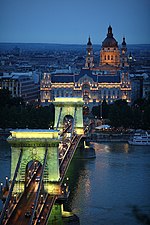Hungary
|
Hungary
Magyarország (Hungarian)
|
|||||
|---|---|---|---|---|---|
|
|||||
![Location of Hungary (dark green)– in Europe (green & dark grey)– in the European Union (green) – [Legend]](http://upload.wikimedia.org/wikipedia/commons/thumb/6/60/EU-Hungary.svg/250px-EU-Hungary.svg.png)
Location of Hungary (dark green)
– in Europe (green & dark grey) |
|||||
| Capital and largest city |
Budapest 47°26′N 19°15′E / 47.433°N 19.250°E |
||||
| Official languages | Hungarian | ||||
| Ethnic groups (2011) |
|
||||
| Demonym | Hungarian | ||||
| Government | Unitary parliamentary constitutional republic |
||||
| János Áder | |||||
| Viktor Orbán | |||||
| László Kövér | |||||
| Legislature |
Országgyűlés (National Assembly) |
||||
| Foundation | |||||
| 895 | |||||
| 25 December 1000 | |||||
| 24 April 1222 | |||||
| 29 August 1526 | |||||
|
• Liberation of Buda
|
2 September 1686 | ||||
| 15 March 1848 | |||||
| 20 March 1867 | |||||
| 4 June 1920 | |||||
| 23 October 1989 | |||||
|
• Joined the European Union
|
1 May 2004 | ||||
| Area | |||||
|
• Total
|
93,030 km2 (35,920 sq mi) (109th) | ||||
|
• Water (%)
|
0.74% | ||||
| Population | |||||
|
• 2016 estimate
|
9,830,485 (88th) | ||||
|
• Density
|
105.9/km2 (274.3/sq mi) (94th) | ||||
| GDP (PPP) | 2016 estimate | ||||
|
• Total
|
$265.037 billion (57th) | ||||
|
• Per capita
|
$26,941 (49th) | ||||
| GDP (nominal) | 2016 estimate | ||||
|
• Total
|
$132.683 billion (58th) | ||||
|
• Per capita
|
$13,487 (57th) | ||||
| Gini (2014) |
low · 16th |
||||
| HDI (2014) |
very high · 44th |
||||
| Currency | Forint (HUF) | ||||
| Time zone | CET (UTC+1) | ||||
|
• Summer (DST)
|
CEST (UTC+2) | ||||
| Date format | yyyy/mm/dd | ||||
| Drives on the | right | ||||
| Calling code | +36 | ||||
| Patron saint | Virgin Mary | ||||
| ISO 3166 code | HU | ||||
| Internet TLD | .hua | ||||
|
|||||
| Current Structure of the National Assembly of Hungary | |
|---|---|
| Structure | |
| Seats | 199 |
 |
|
|
Political groups
|
|
|
Largest urban areas of Hungary
|
||||||||||
|---|---|---|---|---|---|---|---|---|---|---|
 Budapest |
Rank | City | Population | Rank | City | Population |
 Debrecen  Szeged |
|||
| 1 | Budapest | 1,757,618 |
11 | Szolnok | 72,786 | |||||
| 2 | Debrecen | 203,914 | 12 | Tatabánya | 66,791 | |||||
| 3 | Szeged | 162,593 |
13 | Érd | 63,993 | |||||
| 4 | Miskolc | 159,554 | 14 | Kaposvár | 63,742 | |||||
| 5 | Pécs | 145,985 | 15 | Sopron | 61,780 |
|||||
| 6 | Győr | 129,372 |
16 | Veszprém | 60,761 | |||||
| 7 | Nyíregyháza | 118,125 | 17 | Békéscsaba | 60,334 | |||||
| 8 | Kecskemét | 111,836 | 18 | Zalaegerszeg | 58,959 | |||||
| 9 | Székesfehérvár | 98,673 | 19 | Eger | 54,609 | |||||
| 10 | Szombathely | 77,866 | 20 | Nagykanizsa | 48,241 | |||||
Coordinates: 47°N 20°E / 47°N 20°E
– in Europe (green & dark grey)
– in the European Union (green) – [Legend]
Hungary (![]() i/ˈhʌŋɡəri/; Hungarian: Magyarország [ˈmɒɟɒrorsaːɡ]) is a unitary parliamentary republic in Central Europe. It covers an area of 93,030 square kilometres (35,920 sq mi), situated in the Carpathian Basin and bordered by Slovakia to the north, Romania to the east, Serbia to the south, Croatia to the southwest, Slovenia to the west, Austria to the northwest, and Ukraine to the northeast. With about 10 million inhabitants, Hungary is a medium-sized member state of the European Union. The official language is Hungarian, which is the most widely spoken uralic language in the world. Hungary's capital and largest metropolis is Budapest, a significant economic hub, classified as an Alpha- global city. Major urban areas include Debrecen, Szeged, Miskolc, Pécs and Győr.
i/ˈhʌŋɡəri/; Hungarian: Magyarország [ˈmɒɟɒrorsaːɡ]) is a unitary parliamentary republic in Central Europe. It covers an area of 93,030 square kilometres (35,920 sq mi), situated in the Carpathian Basin and bordered by Slovakia to the north, Romania to the east, Serbia to the south, Croatia to the southwest, Slovenia to the west, Austria to the northwest, and Ukraine to the northeast. With about 10 million inhabitants, Hungary is a medium-sized member state of the European Union. The official language is Hungarian, which is the most widely spoken uralic language in the world. Hungary's capital and largest metropolis is Budapest, a significant economic hub, classified as an Alpha- global city. Major urban areas include Debrecen, Szeged, Miskolc, Pécs and Győr.
...
Wikipedia

